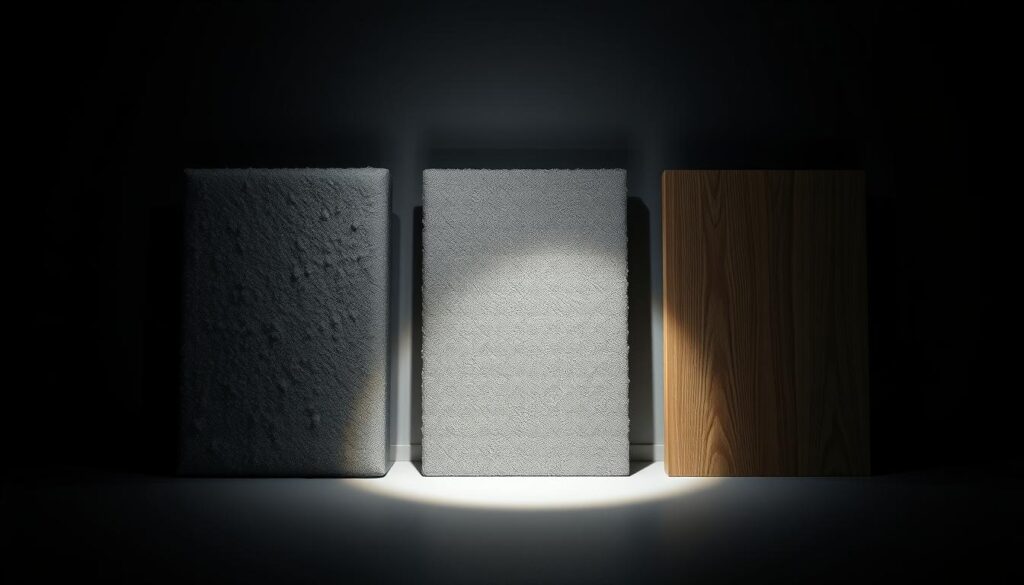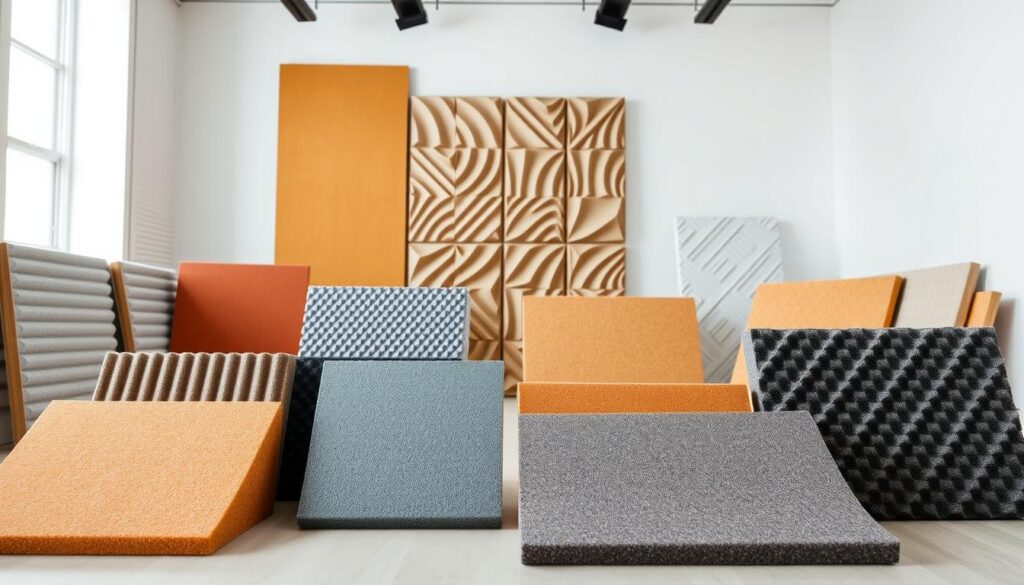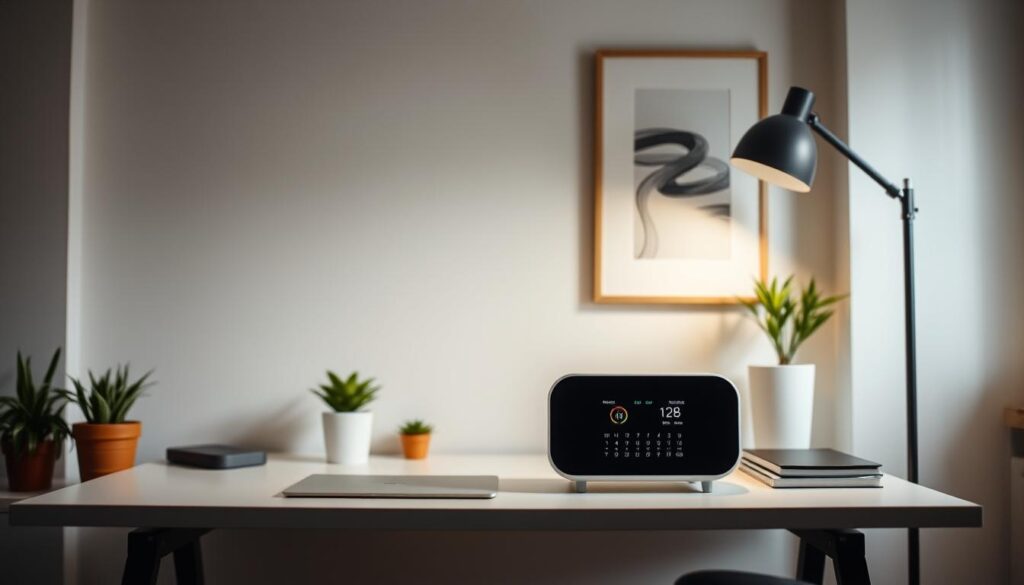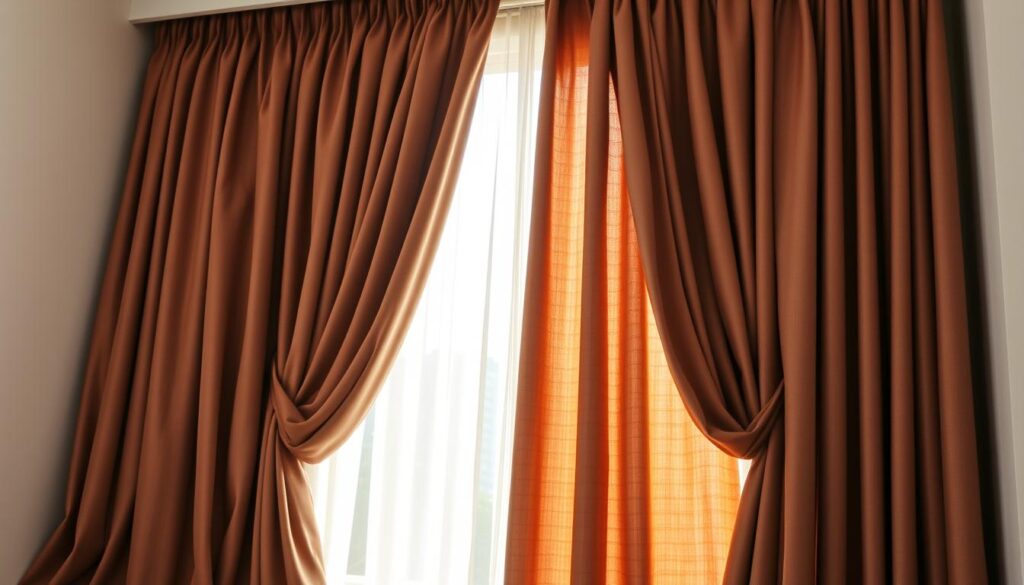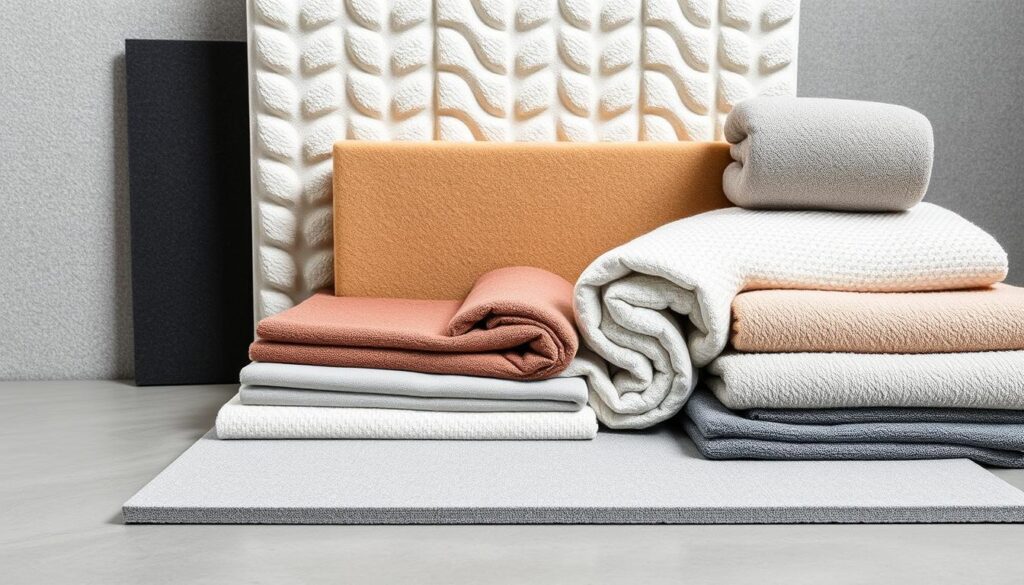Choosing the right acoustic treatment for your space can be tough. There are many materials to pick from. You must think about the space type, look you want, and your budget.
Acoustic panels help soak up sound, cutting down on echoes and reverberations. Foam, fabric, and wood each handle sound waves differently.
Knowing how each material absorbs sound is key to making a good choice. In this article, we’ll dive into the sound-absorbing qualities of foam, fabric, and wood. We’ll help you pick the best one for your needs.
Understanding Acoustic Panels and Their Purpose
To get top-notch sound quality, knowing about acoustic panels is key. These panels are vital for sound management in places like recording studios, home theaters, and conference rooms.
What Are Acoustic Panels?
Acoustic panels are made from a sound-absorbing core and a fabric cover. They’re designed to soak up sound and cut down on echoes. You can find them in foam, fabric, and wood, each with its own perks.
How Do They Work?
Acoustic panels soak up sound waves, which lessens echoes and reverberations. They turn sound energy into heat, which is then lost. The panel’s material and design play big roles in how well it works.
Key factors that influence the performance of acoustic panels include:
- The type of material used
- The thickness and density of the material
- The design and construction of the panel
Why Use Acoustic Panels?
Acoustic panels can greatly boost sound quality by reducing echoes and reflections. This is super important in places where clear sound is a must, like recording studios and home theaters.
By picking the right acoustic panels, you can make your listening experience better. Whether it’s for a home theater or a professional studio, using acoustic panels is a big step towards your sound goals.
Foam Acoustic Panels: An Overview
Foam acoustic panels help control echo and reverberation. They improve sound quality in places like recording studios, home theaters, and offices.
Composition and Construction
Foam acoustic panels are made from open-cell polyurethane foam. This foam absorbs sound energy well. It comes in various densities and thicknesses for different needs.
- Open-cell structure allows for effective sound absorption
- Variety of densities and thicknesses available
- Can be cut to fit specific installation requirements
Sound Absorption Properties
Foam acoustic panels are great at absorbing high-frequency sounds. They turn sound energy into heat, which is then lost in the foam.
- Effective against high-frequency sounds and echoes
- Can help reduce reverberation time in a room
- Available in different NRC (Noise Reduction Coefficient) ratings
Installation and Maintenance
Installing foam acoustic panels is easy. You can attach them to walls or ceilings with adhesives or mechanical fasteners. They need little upkeep, just a soft brush or vacuum cleaner for cleaning.
- Easy to install with various mounting options
- Low maintenance requirements
- Can be replaced if damaged or degraded over time
Fabric Acoustic Panels: The Benefits
Fabric acoustic panels are a smart choice for improving sound quality. They also match well with your room’s look. These panels help make your space sound better and look good too.
Aesthetic Appeal
Fabric acoustic panels are known for their aesthetic appeal. They come in many colors, patterns, and designs. This means you can pick ones that fit your room’s style perfectly.
Versatility and Customization
Fabric acoustic panels are versatile and customizable. You can choose from different fabrics, sizes, and thicknesses. This lets you tailor the panels to your exact needs and style.
Acoustic Performance
These panels are great at absorbing sound, which cuts down on echo and reverberation. The fabric wrap over materials like fiberglass or mineral wool boosts sound absorption. This makes them a top choice for better sound quality.
Adding fabric acoustic panels to your space improves sound and looks. They’re perfect for a home theater, recording studio, or just making your living room sound better. They’re both practical and stylish.
Wood Acoustic Panels: An Elegant Solution
Wood acoustic panels are perfect for those who want both beauty and sound quality. They make a room sound better and look great too.
Design Options and Styles
Wood acoustic panels come in many designs and styles. You can pick from different woods like oak, maple, or cherry. Each wood has its own look and color.
These panels can be finished in many ways. You can stain, paint, or leave them natural. This lets you match them with your room’s look.
Key design features to consider:
- Wood type and grain pattern
- Panel size and shape
- Finish and color options
- Frame design and material
Durability and Longevity
Wood acoustic panels are very durable. With the right care, they can last for years. They also save money in the long run.
To keep your panels looking good, clean them regularly. Don’t use harsh chemicals or too much water. It can harm the wood or change how it sounds.
Acoustic Efficiency
Wood acoustic panels are great at absorbing sound. They help reduce echo and make rooms sound better. The panel’s type, thickness, and how it’s mounted affect how well it works.
Benefits of wood acoustic panels include:
- Effective sound absorption
- Aesthetic appeal and customization options
- Durability and longevity
Choosing wood acoustic panels improves your space’s sound and looks. They are a smart and stylish choice for many uses.
Comparing Acoustic Performance
It’s important to know how different materials absorb sound when picking acoustic panels. Each material has its own strengths and weaknesses. We need to compare them to choose the best one for our space.
Sound Absorption Ratings
Sound absorption ratings tell us how well acoustic panels work. These ratings, like the Noise Reduction Coefficient (NRC), show how much sound a material can soak up. Foam acoustic panels usually have high NRC ratings, making them great at absorbing mid-frequency sounds. On the other hand, fabric-wrapped panels look nice and absorb sound well, but their performance can change based on the fabric and its thickness.
A study showed that some foams can have NRC ratings up to 1.0, which means they absorb sound very well. Wood panels, though, absorb sound but not as much because of their density and surface.
Frequency Range Responses
Each acoustic panel is good at absorbing sound in different frequency ranges. For example, foam panels work well for mid-to-high frequency sounds. Wooden panels, on the other hand, are better at absorbing low frequencies, depending on their design.
- Foam panels: Effective for mid-to-high frequency sounds
- Fabric-wrapped panels: Can be effective across a broad frequency range, depending on the fabric and backing material
- Wooden panels: Can be designed to absorb low frequencies, specially when used in specific configurations or with additional sound-absorbing materials
Applications for Each Material
The right material for acoustic panels depends on the use and the sound quality needed. In recording studios, foam acoustic panels are often chosen because they absorb sound well. For places where looks matter, like conference rooms or auditoriums, fabric-wrapped panels or wooden acoustic panels are better. They offer both good sound absorption and a nice look.
| Material | NRC Rating | Frequency Range | Application |
|---|---|---|---|
| Foam | 0.8-1.0 | Mid-to-High | Recording Studios |
| Fabric-Wrapped | 0.6-0.9 | Broad | Conference Rooms, Auditoriums |
| Wood | 0.2-0.5 | Low | Auditoriums, Theaters |
Cost Factors of Acoustic Panels
Understanding the cost of acoustic panels is key to making a good choice. The price changes based on the material, size, and how they’re installed. This affects the sound quality in your space.
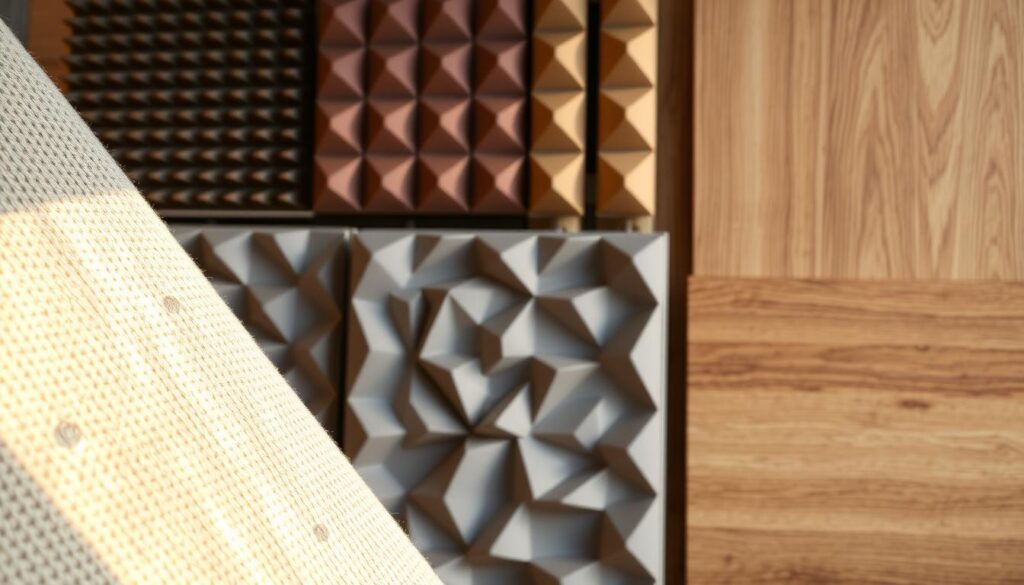
Initial Investment
The cost of acoustic panels is a big factor. Foam acoustic panels are the cheapest, starting at $20. Wood slat panels, on the other hand, are pricier because of the quality and craftsmanship, costing between $100 and hundreds of dollars.
The size of the panel also affects the price. Bigger or custom-made panels cost more. The material’s quality also plays a role; for example, high-density foam or wood can raise the price.
Long-term Value
It’s not just the upfront cost that matters. The panels’ durability is also important. Wood panels, for instance, are not only beautiful but also last a long time with proper care. Foam panels, while cheaper, might need to be replaced more often.
The panels’ ability to absorb sound over time is another key factor. High-quality materials keep their sound-absorbing properties, saving you money in the long run. This means you won’t have to replace them as often or add more treatments.
Comparing Material Costs
Different materials have different prices. Fabric-wrapped panels are in the middle, balancing looks and cost. They’re customizable and effective at absorbing sound, making them a popular choice.
- Foam panels: Cheap, good for sound absorption, but not durable or attractive.
- Fabric-wrapped panels: A good mix of cost and performance, with customization options.
- Wood slat panels: A premium choice with beauty and durability, but more expensive.
Choosing the right acoustic panel material depends on your needs, budget, and goals. Think about both the initial cost and long-term benefits to make the best choice for your space.
Installation Techniques for Different Panels
To get the best sound quality, knowing how to install acoustic panels is key. The right setup can make a big difference. It helps the panels soak up sound and cut down on echoes.
DIY vs. Professional Installation
There are two main ways to install acoustic panels: DIY or hiring a pro. DIY is cheaper and gives you more control. But, it needs careful planning to do it right.
Professional installation, on the other hand, brings in expertise. They know how to pick the best spots for panels. They also have the right tools to make sure panels work their best.
Mounting Options
How you mount acoustic panels depends on the panel type and where you’re putting them. Here are some common ways:
- Adhesive-backed panels for easy installation on smooth surfaces
- Mechanical fasteners for securing panels to walls or ceilings
- Z-clips or French cleats for hanging panels, allowing for adjustable positioning
Picking the right way to mount panels is important. It keeps them stable and working well. The method should also let you make adjustments if needed.
Tips for Optimal Placement
Where you put acoustic panels matters a lot. Here are some tips:
- Find the main sound reflection spots and place panels there.
- Think about the panel’s height and angle to improve sound absorption.
- Spread panels out evenly for a balanced sound.
By following these tips and choosing the right installation method, you can greatly improve your room’s sound. Whether you do it yourself or get a pro, make sure panels are set up to work their best.
Maintenance Requirements of Acoustic Panels
Keeping your acoustic panels in good shape is key to their long-term performance. Regular care helps them keep absorbing sound well. This keeps your space sounding great.
Cleaning and Care
How you clean your acoustic panels depends on their material. Foam panels can be dusted with a soft brush or cloth. Fabric panels need gentle vacuuming or spot cleaning with mild detergent. Wood panels can be dusted with a soft cloth and sometimes polished with wood furniture polish.
General cleaning tips:
- Regularly dust your acoustic panels to prevent dust buildup.
- Avoid using harsh chemicals or abrasive cleaners that can damage the panel materials.
- For fabric panels, test any cleaning solution on a small, inconspicuous area first.
Longevity Considerations
The life of your acoustic panels depends on several things. Quality materials and proper installation are crucial. Also, keeping the environment stable helps prevent damage.
Signs of Wear and Tear
Acoustic panels can wear out over time. Look out for signs like discoloration, sagging, or surface damage. If foam panels are misshapen or fabric is fraying, it’s time for a replacement. Wood panels with scratches or damage might need refinishing or replacing.
By understanding how to maintain your acoustic panels, you can keep them working well. This ensures your space stays acoustically pleasing.
Soundproofing vs. Sound Absorption
To get the best sound quality, it’s important to know the difference between soundproofing and sound absorption. Both are key in managing sound, but they have different goals and methods.
Key Differences Explained
Soundproofing stops sound from getting in or out of a room. It uses materials and methods to block sound. Sound absorption, on the other hand, cuts down on echo and reverberation by soaking up sound energy. Acoustic panels are made for sound absorption, not blocking sound.
Soundproofing uses dense materials like mass-loaded vinyl and sealing gaps. Sound absorption uses materials that soak up sound, like foam, fabric, and wood panels.
Effectiveness of Each Material
The success of soundproofing and sound absorption materials depends on their type. For soundproofing, the material’s density and mass matter. For sound absorption, how well it absorbs sound across different frequencies is important. Foam, fabric, and wood panels each have their own sound absorption strengths, making them good for different uses.
- Foam panels are great for mid-to-high frequency sound absorption.
- Fabric panels are versatile and can absorb sound well, depending on the fabric and design.
- Wood panels can absorb sound and look good, with effectiveness depending on design and construction.
When to Use Which
Choosing between soundproofing and sound absorption depends on your needs. For keeping sound in or out of a room, soundproofing is best. For cutting down echo and reverberation, sound absorption is better. Knowing what you need will help you pick the right approach.
By picking the right acoustic treatment, you can greatly improve your space’s sound quality. Whether you choose soundproofing or sound absorption, picking the right materials and methods is key to getting the results you want.
Making the Right Choice for Your Space
Choosing the right acoustic panel material is key to better sound quality in your space. You need to think about several things. These include the type of space, the look you want, and your budget.
Assessing Your Acoustic Needs
First, figure out the specific sound issues in your space. Think about the room size, the sound you want to control, and how much sound absorption you need. This will help you pick the right Acoustic Panel Materials.
Budget Considerations
Your budget is also important. Look at the prices of different Acoustic Treatment Options like foam, fabric, and wood panels. Remember, some materials might cost more at first but could save you money in the long run because they absorb sound better.
Final Recommendations
After considering your needs and budget, pick the Acoustic Panel Materials that fit your space best. Think about how easy they are to install, how much upkeep they need, and how well they perform. The right choice can greatly enhance your space’s sound quality.
